|
|
|
|


Portraits of Chōgen: The Transformation of Buddhist Art in Early Medieval Japan, by John M. Rosenfield. From the Japanese Visual Culture Series, Volume 1, Brill, Leiden, 2011, Hardcover, 296 pages, 197 illustrations, ISBN13: 9789004168640.
Review by Mark Schumacher, Orientations, Volume 43, Number 1, Jan / Feb 2012.
Decades of brutal civil conflict engulfed Japan in the late 12th century. During the Siege of Nara in 1180, two of the nation's greatest repositories of Buddhist statuary and artwork – Tōdaiji Temple and Kōfukuji Temple – were reduced largely to ashes. The giant bronze Daibutsu (Great Buddha) statue at Tōdaiji, long the preeminent symbol of state-sponsored Buddhism, lay in melted ruin, the head and arms having fallen off when its cavernous hall collapsed around it. The cloistered emperor Go-Shirakawa called its demise a calamity unequaled in China or Japan. At nearby Kōfukuji, clan temple of the powerful Fujiwara family, only a handful of structures escaped the devastating fires. In the months and years after the 'most terrible of terrible things' (p. 109), the throne and nobility gave top priority to repairing the damage.
Enter the pious monk Shunjōbo Chōgen (1121-1206), the central character in Rosenfield's engaging study of Japanese religious art in the early medieval period. Chōgen was assigned the enormous task of soliciting funds and materials for the recasting of the Tōdaiji Daibutsu, rebuilding its grand hall and monastery buildings, and replacing and commissioning countless icons in Nara and elsewhere. Having worked for most of his life on the fringes of the state Buddhist establishment, Chōgen now found himself at its epicenter. He devoted his final 25 years to the project, cajoling Japan's rulers into giving him ever more authority, money, and materials.
Writes Rosenfield: 'Chōgen hired many of the builders, artists, and craftsmen who gave form to the project. He became a diplomat, fundraiser, and contractor, and he journeyed far into the countryside to assemble raw materials. Above all, however, he was a priest who conducted the rituals that endowed the project with spiritual purpose and converted works of art into implements of sacred power (p. 11).'
There is much to praise and little to fault in this lavishly illustrated and meticulously researched work. Among nearly one hundred major statues commissioned by Chōgen, only twenty or so have survived. Rosenfield focuses on these extant icons and the social, stylistic, and ritual contexts in which they were made. By concentrating on Chōgen's story – his religious training, contacts with influential clergymen and lay supporters, knowledge of China, court patronage – the author brings coherence to the otherwise unwieldy corpus of Japanese medieval art and religious practice. Yet this book is exceedingly more than a portrait of one singular monk in an unsettled age. It is also a sweeping survey of Kamakura-era Buddhist statuary, portraiture, architecture, and dedicatory rites. Under Rosenfield's scholarly gaze, Chōgen's story serves as a springboard into much broader socio-political, spiritual, and artistic themes – for example, the use of religious art as an instrument of state policy; the reemergence of Pure Land Amida faith and art and its rapid rise to popularity among the clergy and commoner; the revival of realism in religious statuary; and the appearance, for the first time, of realistic portraiture as a mainstay of religious artwork.
|
|
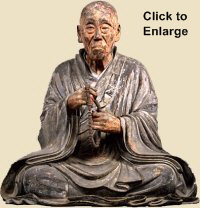
Monk Chōgen Shunjōbō 重源俊乗坊,
circa 1206. Hollow assembled
woodblocks with traces of pigment.
H = 81.8 cm. National Treasure, Tōdaiji.
Rosenfield calls this one of Japan's
oldest surviving examples of true portraiture, one that expresses a "renewed taste for realism" and heralds "many traits of Japanese culture in the centuries to come." Photography by Hiyashizaki Tomoo, photo from
Nara National Museum.
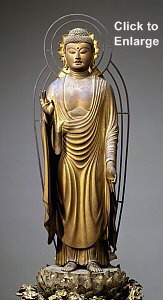
Amida Nyorai 阿弥陀如来
by Kaikei 快慶 (1183-1226).
Hollow assembled woodblocks with polychrome, gold leaf, and crystal decoration. H 98.7 cm, Dated 1202.
Commissioned by Chōgen.
Tōdaiji Temple 東大寺, Nara 奈良. Photography by Asuka-en (Nara),
photo from Nara Nat'l Museum.
|
|
|
|
|
The Kamakura period (1185–1333) rearranged the political, religious, and artistic landscape of Japan. In the political realm, government control shifted to the military (samurai) class and remained there for the next seven centuries. The longstanding sanctity of the throne, the genteel tastes of the aristocracy, and the intellectual elitism of the entrenched monasteries gave way to a new spirit of simplicity, frugality, and manliness. In the religious realm, new and reformed Buddhist movements -- Pure Land, Zen, and Nichiren -- devoted to the salvation of the illiterate commoner gained widespread popularity. These movements stressed pure and simple faith over the complicated rites and doctrines of the traditional monasteries and esoteric schools. Religious art fell naturally under the same leveling impulse, paving the way for greater realism in religious imagery and transforming temple architecture.
Chōgen died in 1206 without witnessing many of these shifts. But, writes Rosenfield, 'early signs of these impending changes can be seen throughout his record……with the statues and buildings that he commissioned incorporating bold innovations' (p. 95). Chōgen died a devout follower of both the older Buddhist traditions as well as a fervent believer in the emerging Amida faith. In his later years, he signified his devotion to Pure Land belief by taking the name Namu Amidabutsu. This name was inscribed inside many statues commissioned by Chōgen, helping Rosenfield positively identify works associated with the monk. In a sense, Chōgen helped usher in Pure Land faith, for he commissioned Kaikei, one of the most celebrated sculptors of the day, to create Pure Land icons whose 'subtle balance and gentle equipoise' served for centuries as a model for Buddhist sculptors (p. 162). He commissioned myriad icons from other artisans as well, including prominent sculptors of the Kei school (who worked on projects for both Tōdaiji and Kōfukuji).
Chapters Four and Five include fascinating accounts of the artists and techniques used to cast the Tōdaiji Daibutsu (and Kamakura Daibutsu), and the inventive mode of construction employed to build the gargantuan hall housing the giant statue. Chapter Six features thumbnail biographies of the sculptors who worked for Chōgen or in his orbit. Also included are accounts of aesthetic standards, craft techniques, and the organization and training of artists.
This book covers much ground. Two items merit special note. First is Rosenfield's keen attention to the dedicatory objects placed inside Buddhist icons, ranging from written vows and donor lists to relics, ritual implements, and scriptures. In many cases, a scroll of the Hōkyōin Darani-kyō (Treasure Casket Seal Incantation) was placed inside the icon to secure the salvation of all those who perished in the recent civil conflicts. Second, the author frequently highlights the preparations and rites conducted by Chōgen to imbue statues with religious energy -- to bring icons 'to life,' to convert them from inert objects into living entities with miraculous powers. These included washing the wood in purification rites, the chanting of darani, the insertion of relics and dedicatory inscriptions, the provision of real clothing, and the eye-opening ceremony (kaigen kuyō). Other highlights include an annotated translation of Chōgen's memoir, short biographies of important supporters, notes on doctrine and ritual, and exact and conscientious treatment of primary texts and secondary literature.
The study of Japanese religious art history has expanded greatly in the West over the past five decades. Until the 1960s, the field was populated mostly by college teachers and museum curators interested in collecting, but they had little or no training in Asian languages. Today the field is rooted firmly in Asian language sources and is highly specialized, with most universities emphasizing cult-specific, site-specific, ritual-specific, and deity-specific studies. These changes have deepened the discipline enormously, despite the tendency of hyper-specialization to narrow the outlook. Rosenfield's work is a welcome addition to a small but growing list of studies that approach the topic from a broad, integrated art-historical view, one with historic breadth and expansive reach. This book is worthy of a prominent spot on the bookshelves of scholars and students of Japanese religious art, pre-modern history, and visual culture.
|
|
|
|
------------------- End Book Review -------------------
|
|
|
|
|
About the Book's Author
|
|
American-born John Rosenfield is a lauded teacher, writer, and historian of Japanese & Asian art. He taught for 25 years at Harvard University before retiring in 1991. He is the recipient of the 1988 Order of the Rising Sun, the recipient of the 2001 Yamagata Banto prize, and in April 2012 he received the Charles Lang Freer Medal in recognition of his contribution to the field of Asian art history. Today he serves as Abby Aldrich Rockefeller Professor of East Asian Art (Emeritus), & Curator of Asian Art at Harvard Univ. Art Museums (Emeritus). John T. Carpenter, the current curator of Japanese art at the Metropolitan Museum of Art (New York), served as the managing editor for Portraits of Chōgen. For more on Rosenfield, see Freer | Sackler.
|
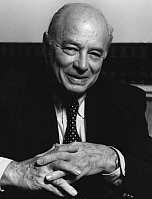
|
|
About the Book's Publisher
|
|
Founded in 1683, Brill is a publishing house with a rich history and a strong international focus. Portraits of Chōgen is the first volume in the multi-volume 'Japanese Visual Culture Series' -- a new academic series devoted to the visual culture of the Japanese archipelago of every era. It will include studies on the history of painting, prints, calligraphy, sculpture, architecture and applied arts, but will extend to the performing arts, cinema, manga and anime. For more, see Brill, Japanese Visual Culture Series. To order Portraits of Chōgen, click here.
|
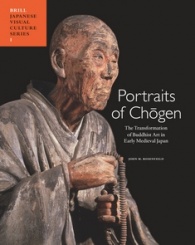
|
|
About Orientations Magazine
|
|
Orientations is read by scholars, collectors and others interested in all aspects of the arts of East, South and Southeast Asia. There are informed articles on the ancient arts of painting, calligraphy, bronzes and ceramics as well as on the decorative arts and crafts. The magazine is renowned for its superb full-colour reproductions on luxury art paper. Many thanks to Orientations magazine for kindly permitting me to reproduce this book review, which first appeared in Volume 43, Number 1, Jan./Feb. 2012. 'Divine Power - The Dragon in Chinese Art' - The Oriental Ceramic Society of Hong Kong • Asian Collections at the Wereldmuseum, Rotterdam • 'Dragons and Lotus Blossoms' - Vietnamese Ceramics at the Birmingham Museum of Art, Alabama. To order visit orientations.com.hk
|
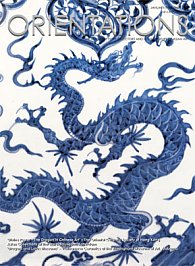
Visit their web site for details
|
|
About the Reviewer
|
|
Mark Schumacher, an independent researcher living in Kamakura, has for the past two decades focused on cataloging the myriad deities in Japan's Buddhist and Shintō pantheons. See his online A-to-Z Dictionary of Japanese Buddhist Statuary.
|

|
|
Related Pages
|
|
|
|

|
|
|